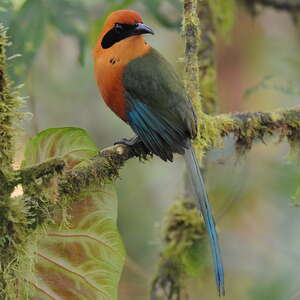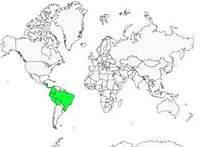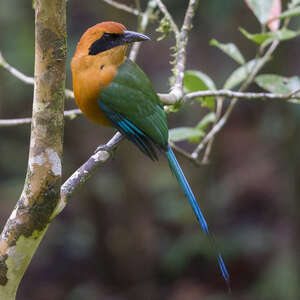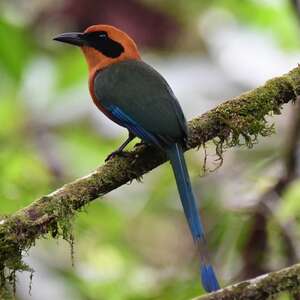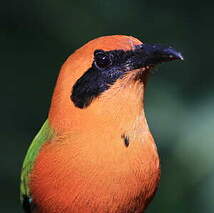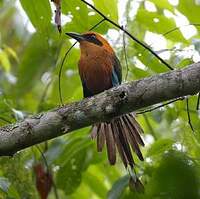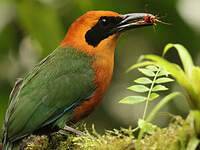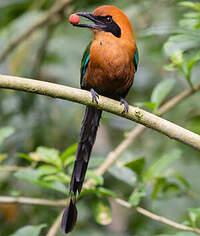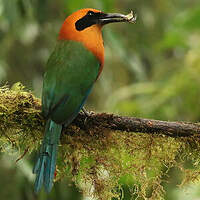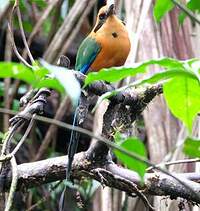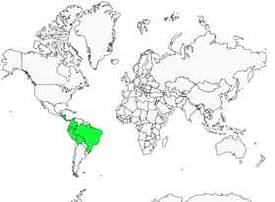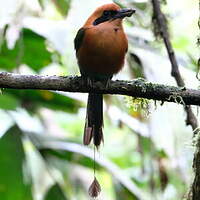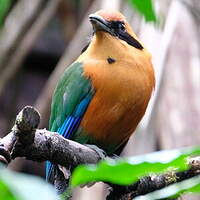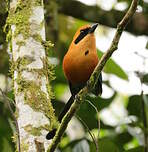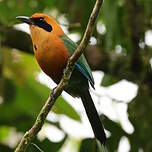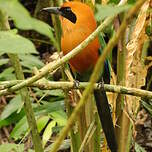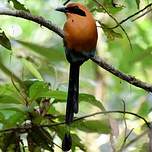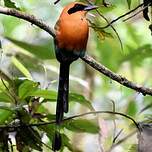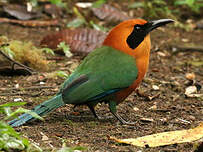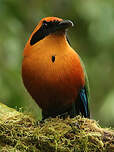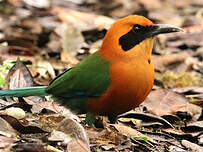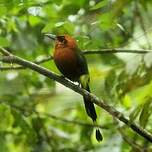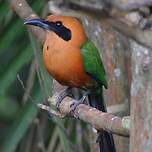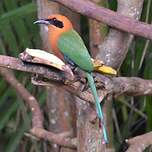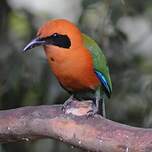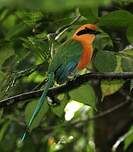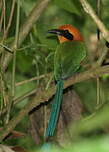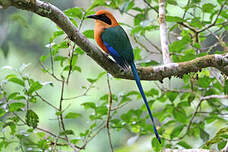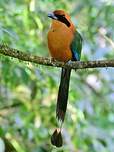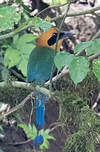Rufous Motmot
Baryphthengus martii - Motmot roux
Identification
The Rufous Motmot, also known as Baryphthengus martii, has an unpronounceable scientific name - a mystery of its own! The first word comes from the Greek baruphthenktes, which could be translated into deep voice (the word baryton surely has the same origin). Martii is a tribute given by Johann Baptist von Spix, a German botanist and zoologist (1781-1826) in honour of Carl Friedrich Philipp von Martius, a German explorer (1794-1868) with whom he explored Brazil from 1817 to 1820. The Rufous Motmot must have called their attention with its varied vocalizations. It belongs to the largest Motmots, with a size of 42 to 47 cm, and it has a quite distinct black, downcurved beak; directly in front of the beak, a broad loral stripe and black post-auricular patches cover the reddish-brown irised eye. The Crown and nape are a beautiful chestnut brown, as are the breast and upper belly; the Rufous Motmot sports two black eyes on its chest which are not always visible - maybecamouflafe for prey? The underbelly is greenish-blue, the mantle can be of various brown shades, and the back is dark green. Its back and primary coverts are a beautiful turquoise blue, while its primary flight feathers are outremer. The tail is extraordinary: it is almost the size of the bird's body, with two central rectrices measuring roughly 110 mm more than the rest, and its colour seems to vary, usually greyish-green or green at the base, and blue or turquoise at the tip. The thighs are green and the tarsi are dark grey; males and females are indistinguishable, and juveniles are similar in colour to adults, but their colours are asyet dull, and the eyes of the chest are not visible yet.There are two subspecies: Baryphthengus martii which gives its name to the species and which has the particularity of having no racket at the end of the tail, two forms are recognized but which are extremely difficult to distinguish, one qualified as pale which presents a duller rufous color and the other qualified as dark; these two forms being probably brought to cross, recognition will remain difficult. Ssp semirufus is slightly larger than ssp martii, the lower abdomen is more turquoise blue than green and above all semirufus presents the two famous rackets at the end of the tail, this ssp can be confused with another motmot, the large-beaked motmot, Electron platyrhynchum, with which it shares the same distribution area. The difference will be made on the size, the large-beaked motmot is smaller, the alula and the primary covers remain green and the throat is slightly marked with blue.
Subspecific information 2 subspecies
- Baryphthengus martii martii (w Amazonia)
- Baryphthengus martii semirufus (e Honduras to nw Colombia and w Ecuador)
Foreign names
- Motmot roux,
- Momoto yeruvá occidental,
- juruva-ruiva,
- Zimtbrustmotmot,
- rozsdásfejű motmot,
- Rosse Motmot,
- Motmot rossiccio,
- rödbrun motmot,
- Kanelmotmot,
- momot škoricový,
- momot skořicový,
- Rødbrun Motmot,
- amazonianmomotti,
- motmot rogenc,
- piłodziób rdzawy,
- cimetasti motmot,
- Рыжий момот,
- アマゾンオオハチクイモドキ,
- 棕翠鴗,
- rödbrun motmot,
- 棕翠鴗,
Voice song and call
The Rufous Motmot sends a two-toned call, boo-boop repeated without interruption every 4 to 6 seconds. The sound is fairly low-pitched and obsessive. A whoop song also low-pitched is also sent on a spaced note every second for periods of 1 to 2 minutes that can make one think of the hooting of a Strigidae.
Habitat
Dietfeeding habits
The Rufous Motmot is a photographer's dream; such a beautiful bird hard to spot despite its size and contrasting colors! But it is certainly a formidable predator whose menu is eclectic: all flying or crawling invertebrates, insects and their larvae, spiders, millipedes, crustaceans and mollusks, as well as reptiles such as lizards, all types of amphibians (including the poisonous, green and black dart frog, Dendrobates auratus).
When it is at the edge of rivers or ponds, it is fishing small fishes, and finally it won't reject small mammals. To have a balanced menu our motmot also eats fruits!Reproduction nesting
From March to June in Costa Rica, juveniles were observed being fed by their parents at the end of June in Panama. The Rufous Motmot nests in a 4-5m long burrow, often on the edge of a stream; they can also use an old den of a small mammal. At present, there is no further information available about the incubation period, feeding, and raising of the chicks.
Geographic range
The Martii subspecies is present in South America, in the Amazon, east of the Equator, southeast of Colombia, northwest of Brazil, south and east of Peru and north of Bolivia; the semirufus subspecies is found in Central America, Honduras, east Nicaragua, Costa Rica and Panama, and also in a small part of South America: northwest Colombia and west of the Equator.
Threats - protection
IUCN conservation status
concern
in the Wild
threatened
evaluated
Fairly common throughout its distribution range, even though it is difficult to spot. If deforestation is a threat to it, it can cope with sparse areas and human proximity, it is sometimes found near feeders where a few seeds or bananas are sometimes welcome!
Sources of information
- IOC World Bird List (v15.1), Gill, F and D Donsker (Eds). 2025-12-07.
- Scientific Birds Names, James A.Jobling
- Vol. 6 - Handbook of the Birds of the World, Josep del Hoyo-Andrew Elliott-Jordi Sargatal
- The Birds of Panama, George R.Anger Robert Dean
- xeno-canto, Sharing bird sounds from around the world,
- BirdLife International, BirdLife International
- Wikipédia, Wikipedia, The Free Encyclopedia
- The internet Bird Collection,
- Neotropical Birds Online,
- HBW Alive,
Other sources of interest
 Specification sheet created on
30/07/2023 by Anne et Gabriel Leboff
Specification sheet created on
30/07/2023 by Anne et Gabriel LeboffTranslation by AI Oiseaux.net
© 1996-2025 Oiseaux.net
- Accipitriformes
- Aegotheliformes
- Anseriformes
- Apodiformes
- Apterygiformes
- Bucerotiformes
- Caprimulgiformes
- Cariamiformes
- Casuariiformes
- Charadriiformes
- Ciconiiformes
- Coliiformes
- Columbiformes
- Coraciiformes
- Cuculiformes
- Eurypygiformes
- Falconiformes
- Galliformes
- Gaviiformes
- Gruiformes
- Leptosomiformes
- Mesitornithiformes
- Musophagiformes
- Nyctibiiformes
- Opisthocomiformes
- Otidiformes
- Passeriformes
- Pelecaniformes
- Phaethontiformes
- Phoenicopteriformes
- Piciformes
- Podargiformes
- Podicipediformes
- Procellariiformes
- Psittaciformes
- Pterocliformes
- Rheiformes
- Sphenisciformes
- Steatornithiformes
- Strigiformes
- Struthioniformes
- Suliformes
- Tinamiformes
- Trogoniformes

